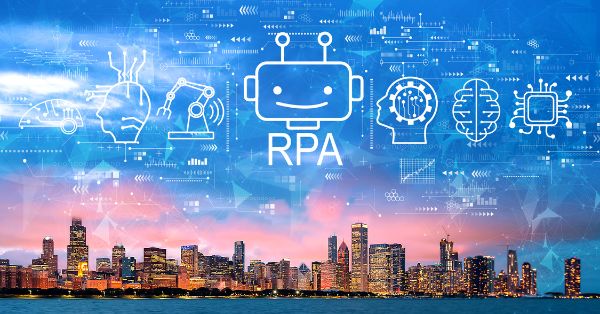Although the word “robot” conjures up ideas of humans, it can refer to anything from software programs to chatbots in information technology. Robots are used in many industries to automate tasks, increasing operating productivity and cutting costs.
The FinTech sector, which employs mobile devices, cloud services, and software, provides the best example of this convergence. In a highly competitive financial environment, organizations strive to improve client experiences by managing payments, investments, insurance, and applications in an effective manner.
Introduction to Robotic Process Automation (RPA) in FinTech
The ultimate automation technology is robotic process automation or RPA. Engineers have configured this computer program or robotic system to imitate human behavior in digital systems. RPA is an efficient way to handle different business operations because it is made to react like a human and is very good at individual human characteristics.
But not every process lends itself to mechanization. Some still require human intervention. For activities like copying, pasting, and extracting data—whether it be semi-structured or structured—RPA excels.
Automating repetitive tasks like logging in, moving files, and filling out forms saves time and effort. RPA effectively automates repetitive, repetitious processes that don’t require much human intelligence.
Use Cases of Robotic Process Automation (RPA) in FinTech
The FinTech software development services industry is highly regulated and subject to stringent bars for data security and quality. It makes sense that financial companies are utilizing robotic process automation on a much larger scale.
1. Client Onboarding
Due to guidelines that banks and other financial institutions must follow, the client onboarding process is frequently lengthy and complicated. By extracting the relevant data from the KYC documents and comparing it with the data in the form of optical character recognition technology (OCR), RPA and AI in banking can expedite this procedure. RPA in financial services will save your personnel time and effort while lowering the possibility of human error.
2. Automation
The banking industry’s more accurate and transparent account creation process makes it easier for customers to open accounts. Removing data conversion mistakes that previously occurred between new bank account requests and the central banking system enhances the overall quality of information inside the organization.
Therefore, RPA in FinTech can ensure high accuracy and reduce costs while eliminating inaccurate and extended data input sequences and drastically cutting turnaround times.
3. Mortgages
Though this service is process-based and rather laborious, mortgage lending is an essential area of concentration for every bank. Document processing, quality audits, and credit arrangement are just a few lending-related banking operations that can run automatically with RPA. More client satisfaction follows from the quicker processing of loan requests.
4. KYC process
Due to their high data volume, KYC and AML processes are perfect candidates for using intelligent automation frameworks. Whether discussing the computerization of manual work or the identification of irregular banking activity, RPA has demonstrated its effectiveness in the financial services industry by saving money and time compared to traditional methods.
5. Suspicious activity reports
(SARs) for fraudulent transactions are the norm at banks and financial services firms worldwide. Compliance experts should routinely review the documents and manually complete the SAR blank with all pertinent data. One benefit of this technology is that robotic process automation software can scan lengthy compliance statements before gathering the readings and filling out a SAR.
Advantages of Robotic Process Automation in FinTech
The value of the worldwide RPA market was $1.57 billion in 2020. Grand View Research projects that by 2028, the figures will increase at a CAGR of 32.8%. These graphs show how the corporation needs to use RPA to improve its financial department. Here are some advantages to consider.
1. Improved Customer Service
The RPA is a beneficial addition to this area. Suppose banks and other financial organizations like them put up chatbots available around the clock, seven days a week.
In that case, customers will feel more at rest knowing that someone is there to answer their queries or address their difficulties at any time of day or night. They remain faithful to their respective banks and organizations as a direct result.
Since RPA software reduces the time spent processing information, customers love it. Also, there are fewer instances of mistakes happening during the activities. Because of this, financial transactions are a great deal faster and more precise than other kinds.
2. Enhanced Input and Effort
Compared to humans, RPA systems work at an unparalleled speed, handling duties like precision data collection and fast system interface with older systems. RPA encourages businesses to switch from old to modern technologies by finding and fixing operational inefficiencies.
On the other hand, workers often put a lot of time into monotonous tasks, which impedes their ability to personally and professionally advance. RPA ensures error-free processes, minimal delays, and increased customer satisfaction by freeing up underwriters to concentrate on complex claims, as demonstrated by routine insurance claims processing. The effectiveness of RPA improves customer satisfaction, staff productivity, and streamlining procedures.
3. Better Returns on Investment
Individuals are willing to invest their money in various investment forms, such as mutual funds, stocks, and other investment options that RPA systems provide information and values.
As a result, investors can keep a closer eye on each portfolio individually. Similarly, there are no costs for individuals to receive financial counseling. Viewed from this perspective, RPA proves to be a reasonable tool for growing a robust client base.
4. Improved Procedures for the Accounting System
RPA can assist in expanding the efficiency of the data collection process because it works with a wide range of applications. The processing of invoices, other document maintenance, and the balance sheet are all automated.
Best Practices for Robotic Process Automation in FinTech
Here are some of the best practices of RPA in FinTech to consider and how it can achieve operational excellence.
1. Determine Which Processes Are Good for Automation
Not every process lends itself to automation. Rules-based, repetitive, and time-consuming procedures must be recognized as ideal candidates for RPA implementation. Financial institutions may optimize the advantages of automation, like improved accuracy, quicker response times, and lower expenses, by focusing on the appropriate operations.
Prerequisites for successful implementation include a thorough assessment of current practices and the designation of those that integrate well with automation technologies. Ascertain which procedures require a high volume of transactions, manual data entry, or readily repeatable rules.
2. Perform Thorough Validation and Testing
Implementation of RPA technologies in a production environment requires extensive testing and validation. Organizations must guarantee that automated processes operate as anticipated, proficiently manage anomalies, and merge with pre-existing systems.
Thorough testing reduces the possibility of mistakes and interruptions, guaranteeing a seamless shift to automation. Validation ensures that the automation conforms with legal standards and appropriately represents the intended outputs. Make a thorough testing plan that covers integration testing with other systems, exception management, and functional testing.
3. Strict Security Measures in Place
Considering how sensitive financial data is, security is crucial while implementing RPA. Organizations must implement robust security protocols to protect confidential information throughout transmission and automated system storage. A thorough RPA security framework must include encryption, secure access controls, and frequent security audits.
Creating a secure automation environment guarantees adherence to industry rules and protects against data breaches. Establish access restrictions and authentication procedures to safeguard private information and focus on user behavior.
4. Center of Excellence
A best practice that guarantees effective implementation and long-term sustainability is to designate a Center of Excellence (CoE) devoted to RPA. For RPA governance, expertise, and information sharing, the CoE acts as a single point of contact.
It suggests standardizing tools and procedures, RPA strategy, and implementation techniques. In addition, the CoE is essential for staff training and upskilling, encouraging RPA use, and promoting automation efforts’ ongoing progress.
Companies Using Robotic Process Automation in FinTech
The FinTech sector is distinguished by a wide range of data-intensive procedures, onerous legal obligations, and an unwavering need for precision and quickness. RPA’s entrance into this market has been a game-changer because it tackles the primary issues facing it.
Leading FinTech business Stripe uses RPA to automate its payment processing processes. Transaction reconciliation, customer data validation, and fraud detection are among the tasks that RPA bots are responsible for.
1. Stripe
Stripe can effectively handle millions of transactions by automating these procedures, which lowers the risk of human error and guarantees quicker, more secure payment processing for its clientele worldwide. It has made Stripe more competitive in the online payment space and attracted many businesses that value reliability and effectiveness highly.
2. Robinhood
The commission-free trading platform Robinhood uses RPA to enhance customer support. RPA bots answer standard customer queries like balance checks, password resets, and account verification.
The customer care team at Robinhood can concentrate on fixing more complicated problems and giving each user individualized attention by automating these chores. Shorter response times and more efficient query resolution are responsible for higher customer satisfaction and loyalty among Robinhood’s continuously growing user base.
Wrapping Up
RPA may help businesses identify and remove pain points, maintain audit trails, increase accuracy while cutting costs, and guarantee regulatory compliance. Automating tasks that are now meticulously, persistently, and manually carried out could revolutionize the banking sector and increase client satisfaction.
With the financial industry experiencing significant upheaval, robotic process automation is poised to become an important development strategy. It allows firms to cut expenses, increase accuracy and compliance, and streamline operations.








































